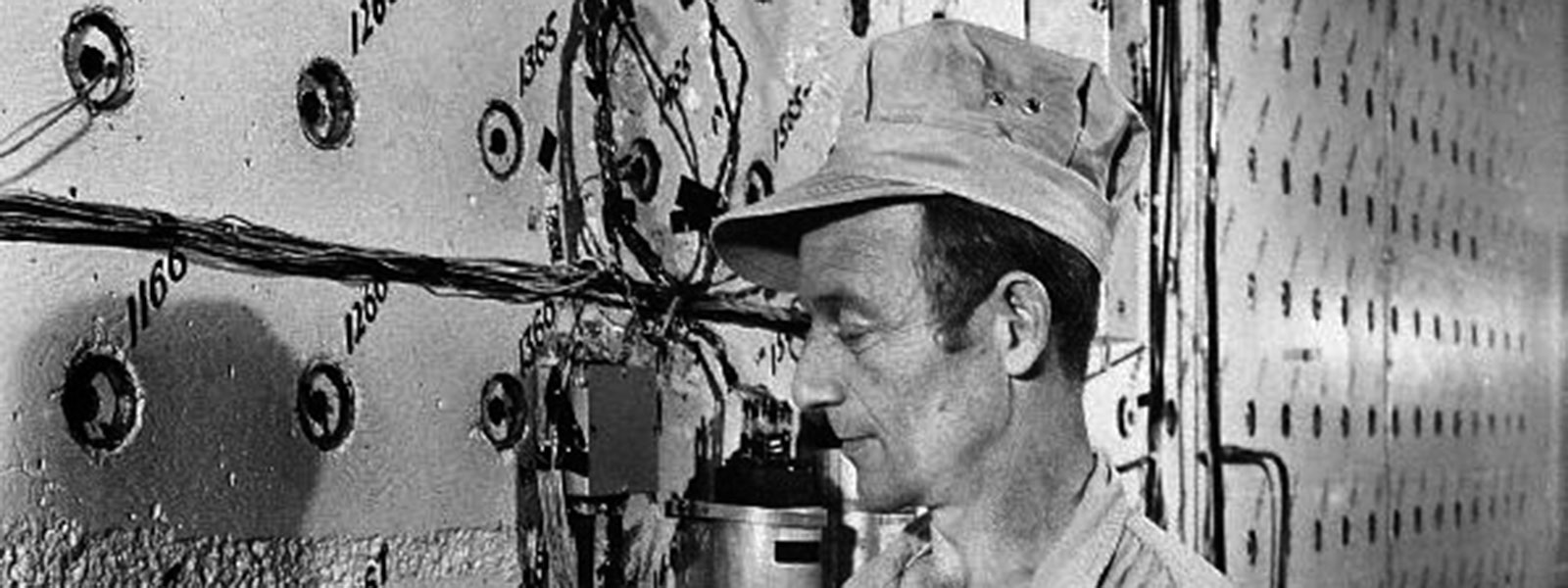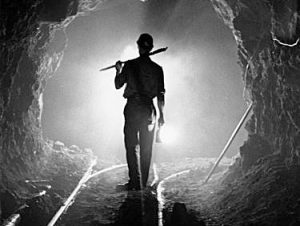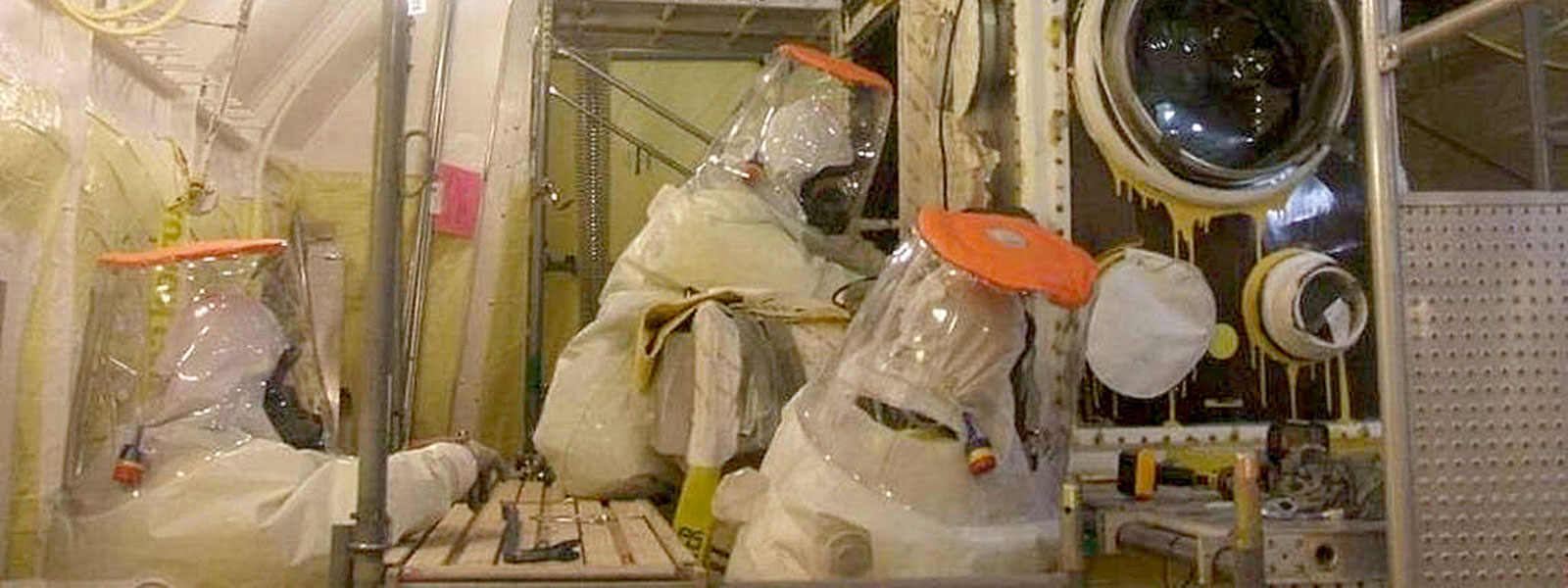
Our Nuclear Nation
Experience the History
NUCLEAR WEAPONS 101
Types of Weapons:
There are two basic types of nuclear weapons: fission and fusion. The earliest nuclear weapons were fission and made from uranium and plutonium. These were the devices used in WWII and were the type of weapons used on Hiroshima and Nagasaki.
After WWII, fusion weapons were created to be more efficient, smaller, and lighter. These weapons are often referred to as hydrogen bombs and consist mainly of deuterium and tritium. While fusion weapons are more effective, they are more difficult to produce because some gases are hard to store safely, some are in short supply, and high temperature and pressure are required to produce a fusion reaction.

Uranium Mining, Milling, and Transport
Uranium was a key element in building a nuclear weapon. Uranium ores were mainly found in mines in Utah, Colorado, New Mexico and Arizona also in an area known as the Four Corners. Once the uranium was taken from the mines, it would be transported by truck or railroad to a mill where it was refined into “yellowcake”, which is another name for uranium oxide.

At the start of the Manhattan Project, most uranium was imported from other countries. In the U.S. uranium was primarily a by-product of mining for other minerals. Once the Manhattan Project was in full force, an initiative was made to extract any remaining uranium from mines in Wyoming, Utah, Colorado, New Mexico, Arizona and Texas.
Unfortunately, at the time, the health issues attributed to uranium exposure were not known and uranium workers did not take the safety precautions commonly practiced today. People were even known to have pieces of yellowcake in their homes and there were a few children’s toys sold in the 1950s that contained real uranium ore!
Refineries, Foundries, and Fabrication
While scientists worked to create a weapon that had never been built, others were working simultaneously to develop processes and devices to refine and fabricate uranium and plutonium in a way to be used as fuel for the weapons. At the beginning of the Manhattan Project, the largest supply of uranium in the U.S. came from foreign sources. However, in many of the western states, uranium-rich mine tailings existed from the vanadium mines. Over 3 million tons of these tailings in Durango and Uravan, CO were shipped to Grand Junction, CO for further refining.

Uranium hexafluoride gas, UF6, is the most useable form of uranium. Several facilities provided intermediate products (feed materials) like brown oxide and green salt for use in the chain process of creating UF6. Some of these facilities included Linde Air Products (NY), Mallinckrodt Chemical Works (MO), and Ames Laboratory (IA).
Prior to 1950, the processing of uranium into uranium metal was done at over 20 small facilities spread throughout the U.S. However, starting in 1951 the processing was consolidated to the Feed Materials Production Center near Fernald, OH and the Weldon Spring Feed Materials Plant in Weldon Spring, MO. Because the majority of facilities worked in secrecy even after WWII, many employees and local residents thought the Feed Materials Production Center produced animal feed, not nuclear materials.
Uranium Isotope Enrichment
The uranium isotope needed to produce a nuclear chain reaction is called U235, but this isotope occurs in less than 1% of naturally occurring uranium. Therefore, processes had to be developed to separate the U235 isotope from uranium samples. Scientist Ernest Lawrence created a device called a “Calutron”. These Calutrons were built at the Y-12 facility in Oak Ridge, TN.
A second method was developed called gaseous diffusion. This method replaced the Calutrons once the process was perfected. Three main gaseous diffusion plants were located in Oak Ridge, TN, Portsmouth, OH and Paducah, KY.
Production of Other Crucial Materials (Plutonium and Heavy Water)
Plutonium was another crucial fissile isotope and superior to U235 due to its higher probability of fission. The experimental X-10 Graphite Moderated Reactor in Oak Ridge, TN was the first to produce significant amounts of plutonium, but the Hanford facility in Washington was created to produce large amounts of plutonium for the Manhattan Project. The B reactor built in 1944 was the first large-scale nuclear reactor.
“Heavy water” is used to slow down the reaction in a reactor. Heavy water contains a neutron moderator because the nucleus has a proton and one or two neutrons. The Savannah River Site (SRS) in South Carolina was built in 1953 to operate heavy water moderated reactors that produced plutonium and tritium.
Component Fabrication and Assembly
Many other sites produced components or assembled the components into the final nuclear weapon.
Rocky Flats in Colorado manufactured over 70,000 plutonium triggers in 40 years. Mound Laboratory in Ohio created neutron generators made from polonium, beryllium, deuterium, and tritium. The Pinellas Plant in Florida also made neutron generators for 10 years starting in 1957. Lawrence Livermore National Laboratory in California developed processes and equipment for the design and testing of thermonuclear weapons. Sandia Laboratory in California and New Mexico primarily assembled warheads from 1948-1952, but then became part of the design and engineering of weapons safety and security. Iowa Army Ammunitions Plant (IAAP) in Iowa started with conventional explosives, but then produced high explosives for nuclear warhead assemblies.
Los Alamos, NM was the first nuclear weapons assembly site that resulted in the first nuclear weapon detonated at the Trinity site in 1945. Just a few weeks later these weapons were used over Hiroshima and Nagasaki, Japan to end WWII.
The Nevada Test Site, north of Las Vegas, Nevada was the scene of more than 1,000 tests of nuclear weapons.
Finally, the Pantex Plant, which is still active today, has assembled or upgraded over 32,000 nuclear weapons and disassembled over 50,000 nuclear weapons.
Weapons Testing
Testing nuclear weapons in the U.S. occurred from 1945 until 1992. Testing included above ground, underwater, underground and outer space. The first nuclear weapons test took place at the Trinity Site at the White Sands Test Range in New Mexico. Officially the U.S. has conducted over 1,054 nuclear tests with the majority taking place at the Nevada Test Site and the Pacific Proving Grounds. The Nevada Test Site alone, north of Las Vegas, Nevada was the scene of more than 1,000 tests of nuclear weapons.
Nuclear Weapons Today
Even with the end of the Cold War and various nuclear treaties in effect, the money spent on nuclear weapons continues today. The Pantex Plant in Texas recently completed a major expansion to increase its ability to assemble up to 600 nuclear warheads per year. New tritium reservoirs and uranium reprocessing continue at Y-12 Plant in Tennessee. Sandia Laboratory has increased its manufacturing of neutron generators to over 1500 per year. Fourth generation designs are being developed to be processed without special nuclear materials like U235 and Plutonium.
70,000 warheads have been produced to date in the U.S. Only 6,800 are still in existence, though many are deactivated. Over 5,000 are currently active and deployable if needed to defend our country.
